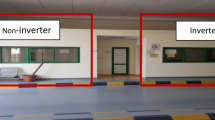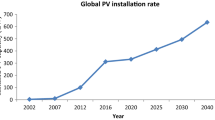Abstract
The device that controls dynamic motions in a washing machine is called as MICOM. This device includes an IPM that controls the rotation of a tub. Also, the overheating of IPM gives cause for lowering the service life of an applied chip and is directly linked with its faults. A heat sink that is larger than the volume of the applied chip more than 50 times is installed to prevent such overheating. In the operation of the IPM, the temperature specification of the heat sink can be determined as 80°C under the air temperature of 25°C. However, the heat sink used at the present time cannot satisfy this condition, so it is necessary to redesign such a heat sink to satisfy this condition. This study proposes an STM that is able to precisely calculate the temperature applied to IPM in a system level prior to redesigning the heat sink. The STM can be considered as a model that complements a JEDEC analysis model. This model implements a parameter analysis to perform the optimization of a heat sink and verifies the priority of parameters to reduce material costs. Furthermore, it investigates a counterproposal that replaces the conventional cooling methods in which it seeks a counterproposal that performs heat dissipation in a device according to the SoC of chips and is able to suppress EMI.
Similar content being viewed by others
References
S. Krishnamoorthi, K. Y. Goh, Desmond Y. R. Chong, R. Kapoor and Anthony Y. S. Sun, Thermal characterization of a thermally enhanced QFN package, 2003 Electronics Packaging Technology Conference, (2003).
D. J. Kim and S. J. Kim, Compact modeling of fluid flow and heat transfer in straight fin heat sinks, ASME Journal of Electronic Packing, 126 (2004) 247–255.
J. Richard Culham and Yuri S. Muzychka, Optimization of plate fin heat sinks using entropy generation minimization, IEEE Transactions on Components and Packaging Technologies, 24(2) (2001) 159–165.
K. W. Park, P. K. Oh and H. J. Lim, Optimum design of a pin-fins type heat sink using the CFD and mathematical optimization, International Journal of Air-Conditioning and Refrigeration, 13(2) (2005) 71–82.
K. J. Riu, C. W. Park, C. S. Jang and H. W. Kim, Cooling characteristics of wing fin heat sink, Korean Journal of Air-conditioning and refrigeration Engineering, (In Korean), 16(8) (2004) 728–740.
J. H. Kim, J. H. Yun, O. K. Kwon and C. S. Lee, An experimental study on the thermal resistance characteristics of layered heat sink, Korean Journal of Air-conditioning and refrigeration Engineering, (In Korean), 13(4) (2001) 271–279.
http://www.ates.co.kr/, qfin 3.1 S/W.
E. S. Cho, M. N. choi, C. H. Jung, et. al., Set-level thermal management with package thermal design in digital TV application, 11 th ITherm Conference, Orlando, Florida, USA. (2008) 598–603.
S. Y. Kim and R. L. Webb, Analysis of convective thermal resistance in ducted fan-heat sinks, IEEE Transactions on Components and Packaging Technologies, 29(3) (2006) 439–447.
Z. Duan and Y. S. Muzychka, Impingement air cooled plate fin heat sinks part II-thermal resistance model, 2004 Inter Society Conference on Thermal Phenomena, (2004) 436–443.
A. Nakata, S. Tanaka, K. Sugano, T. Tsuchiya and O. Tabata, Electrical equivalent circuit model of microfluidic system containing piezoelectric valveless micropump and viscoelastic PDMS microchannel, Mechanical Engineering Congress, (In Japanese), Japan(MEC J-08), 8 (2008) 23–24.
EIA/JESD51-2, Integrated circuits thermal test method environment conditions-natural convection (still air), (1995).
J. R. Culham, M. M. Yovanovich and S. Lee, Thermal modeling of isothermal cuboids and rectangular heat sinks cooled by natural convection, IEEE Transactions on Components, Packaging, and Manufacturing Technology-part A, 18(3) (1995) 559–566.
J. P. Holman, Heat transfer 7th edition in SI units, McGraw-Hill Book Company, McGraw-Hill International, UK, (1992) 42–65.
H. Shaukatullab, W. R. Storr, B. J. Hansen and M. A. Gaynes, Design and optimization of pin fin heat sinks for low velocity applications, Twelfth IEEE SEMI-THERM™ Symposium, Austin, TX, USA. (1996) 151–163.
C. J. Shih and G. C. Liu, Optimal design methodology of plate-fin heat sinks for electronic cooling using entropy generation strategy, IEEE Transactions on Components and Packaging Technologies, 27(3) (2004) 551–559.
T. Y. Wang and C. C. P. Chen, SPICE-compatible thermal with lumped circuit modeling for thermal reliability analysis based on modeling order reduction, IEEE Computer Society, (2004).
Y. Joshi, M. Baelmans, D. Copeland, C. J. M. Lasance, J. Parry and J. Rantala, Challenges in thermal modeling of electronics at the system level, IEEE Transactions on Components and Packaging Technologies, 24(4) (2001) 611–613.
Author information
Authors and Affiliations
Corresponding author
Additional information
This paper was recommended for publication in revised form by Associate Editor Jae Dong Chung
Chung-Hyo Jung acquired the doctoral degree in the Dept. of Science for Open and Enviromental Systems at Keio University in 2003. The specialty in the doctoral course was GSMAC-FEM and studied on MHD (magnetohydrodynamics). Dr. Jung joined Samsung Electronics Co., Ltd. as a CFD engineer in 2003. Also, he has worked at Samsung Advanced Institute of Technology and has charged in the thermal analysis of semi-conductors (system LSI). One of the Dr. Jung’s major concerning fields is the mechanical application of Lie-Groups.
Rights and permissions
About this article
Cite this article
Jung, CH., Chung, YS. & Lee, HW. Investigation on thermal characteristics of heat sinks for power module using STM. J Mech Sci Technol 23, 686–697 (2009). https://doi.org/10.1007/s12206-008-1217-8
Received:
Revised:
Accepted:
Published:
Issue Date:
DOI: https://doi.org/10.1007/s12206-008-1217-8




